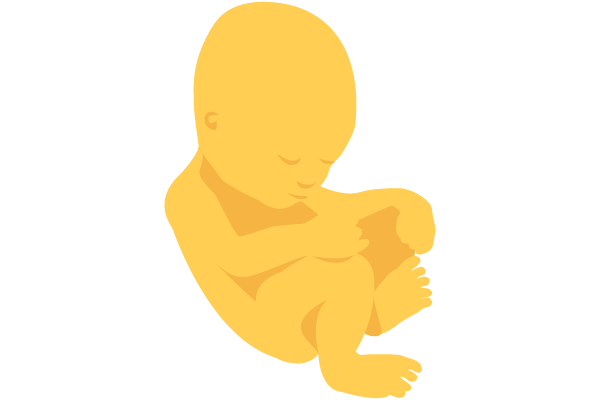
36 weeks pregnant
For information about weeks 36 to 37 in a twin or multiple pregnancy, tap here.
Baby could be making some big moves these days, moving down to your pelvis as they get ready to make their grand entrance!
How’s Baby?
In week 36, Baby is probably close to 19 inches (47.8 cm), and 6 lbs (2.7 kg), about the size of a papaya, although variation in the height and weight of each individual baby increases as they get closer to birth, and when your little one arrives they should be just the perfect size for them! At this point, if Baby is still in the breech position, your healthcare provider may talk to you about ways to try to get them into a head-down (vertex) position for safe labor and delivery. Your baby’s digestive system still isn’t fully developed yet. Although Baby has had plenty of practice swallowing amniotic fluid, they won’t be digesting food until they start eating on the outside.
Speaking of which, if you haven’t thought much about it yet, you should spend some time thinking about how you want to plan to feed Baby once they’re born. Breastfeeding is an excellent way to bond with your baby and make they get the nutrients they need, but it's not the only way to do things. Bottle feeding can also be an intimate, special time. Many parents feed their babies with some combination of these methods. And while it can be helpful to plan for these things advance, once Baby arrives you should do whatever is right for you and your little one.
What's new with you?
Because Baby is moving down to your pelvis in advance of birth, the pressure on your lungs is probably lightening up, making breathing easier again. When your baby moves down in this way it’s called lightening, and it’s often considered one of the first signs of labor, though if it’s your first pregnancy it could happen weeks before you go into active labor. And while you may be breathing easier, you’ll probably still be dealing with a number of other discomforts as a result of this move, like increased pelvic discomfort and pressure on your bladder. Heartburn and insomnia may still be bothering you at this point too. Swollen feet could be doing the same, and if yours have grown significantly during pregnancy, they could remain a larger size even after birth.
As you approach delivery day, make sure that you know the symptoms of labor so you can be ready for your little one’s arrival. And if you experience signs of preterm labor, including vaginal bleeding, back pain and pelvic/vaginal pressure, and preterm, premature rupture of membranes, contact your provider right away. Diarrhea, increased contractions, and your water breaking can all be signs that you might be going into labor. When your “water” breaks, what’s really leaking is the amniotic fluid, and sometimes it can be a little tough to tell if it’s the real thing when it happens, as for some people it might seem like you just peed yourself a bit. Make sure you talk to your healthcare provider about what water breaking will really be like, so that you can recognize it when it comes. Some of the major differences between amniotic fluid and urine are color (amniotic fluid is often lighter, ranging from clear to a very pale, straw color) and odor (the smell of amniotic fluid can range from odorless to a faintly sweet or almond-like smell). Once you have a good sense of what the signs of labor are, make sure you have your hospital or birthing center to-go bag ready and any other necessary plans in place, and then you and Baby should be ready to go!
Reviewed by the Ovia Health Clinical Team
Read more
Sources
- Mayo Clinic Staff. "Water breaking: Understand this sign of labor." Mayo Clinic. Mayo Clinic. June 16, 2019. https://www.mayoclinic.org/healthy-lifestyle/labor-and-delivery/in-depth/water-breaking/art-20044142/.
- "Amniotic fluid." U.S National Library of Medicine. MedlinePlus. February 26, 2021. https://medlineplus.gov/ency/article/002220.htm.
- "Why breastfeeding is important." Office on Women’s Health in the U.S. Department of Health and Human Services. March 14, 2019. https://www.womenshealth.gov/breastfeeding.
- "Shortness of breath." March of Dimes. March of Dimes. August 2009. https://www.marchofdimes.org/complications/shortness-of-breath.aspx.
- Mark A Curran, M.D. “Fetal Development.” Perinatology.com. Perinatology.com. March 31, 2019. https://www.perinatology.com/Reference/Fetal%20development.htm#1.




